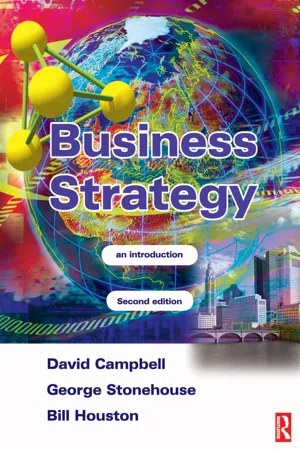
Business Strategy
George Stonehouse, Bill Houston
- 475 pages
- English
- ePUB (mobile friendly)
- Available on iOS & Android
Business Strategy
George Stonehouse, Bill Houston
About This Book
'Business Strategy: an introduction' is an accessible textbook that provides a straightforward guide for those with little or no knowledge of the subject. It presents complex issues and concepts in a clear and compact manner, so that readers gain a clear understanding of the topics addressed. The following features are included: * A comprehensive introduction to the subjects of business strategy and strategic management
* Complex issues explained in a straightforward way for students new to this topic
* Student friendly learning features throughout
* Case studies of varying lengths with questions included for assignment and seminar work
* A discussion of both traditional theory and the most recent research in the fieldThis second edition features new and updated case studies as well as more depth having been added to the material in the book. New chapters on business ethics, types and levels of strategy, and how to use case studies have been incorporated. A range of pedagogical features such as learning objectives, review and discussion questions, chapter summaries and further reading are included in the text resulting in it being a user-friendly, definitive guide for those new to the subject.A web-based Tutor Resource Site accompanies the book.
Frequently asked questions
Chapter 1 Strategy and strategic management
Introduction and chapter overview
Learning objectives
- define the word strategy using Mintzberg's five Ps framework;
- distinguish between deliberate (prescriptive) and emergent strategy;
- explain what strategy contains in practice;
- describe the different frameworks by which strategy is understood;
- describe what is meant by strategic, tactical and operational decisions;
- explain what is meant by hierarchical congruence and why is it important;
- explain the stakeholder model to show how strategic decisions are arrived at.
What is strategy
Definition
Definitions
Mintzberg's 5 Ps
- a plan;
- a ploy;
- a pattern of behaviour;
- a position in respect to others;
- a perspective.